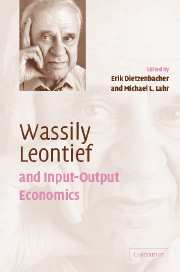Book contents
- Frontmatter
- Contents
- List of contributors
- List of figures
- List of tables
- Preface
- Part I Reflections on input-output economics
- 1 A portrait of the master as a young man
- 2 Leontief's “magnificent machine” and other contributions to applied economics
- 3 Leontief and the future of the world economy
- 4 International trade: evolution in the thought and analysis of Wassily Leontief
- 5 Leontief's input-output table and the French Development Plan
- 6 Leontief and dynamic regional models
- 7 Experiences with input-output and isomorphic analytical tools in spatial economics
- 8 Leontief and Schumpeter: a joint heritage with surprises
- 9 Some highlights in the life of Wassily Leontief – an interview with Estelle and Wassily Leontief
- Part II Perspectives of input-output economics
- Subject index
- Author index
7 - Experiences with input-output and isomorphic analytical tools in spatial economics
Published online by Cambridge University Press: 22 September 2009
- Frontmatter
- Contents
- List of contributors
- List of figures
- List of tables
- Preface
- Part I Reflections on input-output economics
- 1 A portrait of the master as a young man
- 2 Leontief's “magnificent machine” and other contributions to applied economics
- 3 Leontief and the future of the world economy
- 4 International trade: evolution in the thought and analysis of Wassily Leontief
- 5 Leontief's input-output table and the French Development Plan
- 6 Leontief and dynamic regional models
- 7 Experiences with input-output and isomorphic analytical tools in spatial economics
- 8 Leontief and Schumpeter: a joint heritage with surprises
- 9 Some highlights in the life of Wassily Leontief – an interview with Estelle and Wassily Leontief
- Part II Perspectives of input-output economics
- Subject index
- Author index
Summary
Introduction
Concepts of input-output analysis pervade economics. In a study dedicated to Wassily Leontief, Varii Auctores (1966, epigraph) stated that “dependence and independence, hierarchy and circularity (or multiregional dependence) are the four basic concepts of structural analysis.” Indeed, in this chapter I argue that input-output relationships may well be even more important at the level below that of a national geography. Thus, I do not dwell here upon non-spatial studies in which the input-output framework is encountered or general introductions to spatial input-output analysis (e.g. Paelinck and Nijkamp, 1975, chapter 5), nor do I dwell upon studies that are not directly relevant, although possibly related. Instead I present a personal reconnaissance in spatial analysis, focusing upon applications of input-output.
My work on spatial analysis began with a study on the workings of a regional economy based on metalworking and, to a lesser extent, on chemicals (Davin et al., 1959; see more below in section 2.1). Technology links between the activities studied were a central part of the analysis, although, due to a lack of regional input-output tables in the mid-1950s, the technology chains (henceforth referred to using the French term “filières”) could only be analyzed qualitatively. This study was the primary foundation of my later thinking (see Paelinck, 1963) on the contents of a theory of polarized regional growth put forward by François Perroux, in which input-output concepts play a central role.
- Type
- Chapter
- Information
- Wassily Leontief and Input-Output Economics , pp. 102 - 122Publisher: Cambridge University PressPrint publication year: 2004



